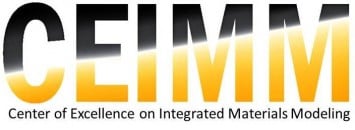Seminar: Satish I. Rao, September 3, 2013
CEIMM-HEMI joint Seminar
Use of Large-Scale Atomistic and Discrete Dislocation Dynamics Simulations for Quantifying Dislocation Behavior and Strengthening in Metallic Alloys
Dr. Satish I. Rao
Senior Research Scientist, UES Inc.
Large-scale atomistic and discrete dislocation dynamics simulations are useful tools for quantifying dislocation behavior and strengthening in metallic alloys. Three examples illustrate use of these techniques: a) 2D discrete dislocation dynamics simulations of precipitation hardening in 2-phase superalloys, b) 3D dislocation dynamics simulations of the size-affected mechanical response of micrometer-scale FCC, as well as two-phase superalloy crystals and c) molecular dynamics simulations of the intrinsic Peierls lattice resistance for <a> type screw dislocations in hcp α-Ti oriented for prism slip. In the first example, discrete dislocation simulations show the effects of size, shape, volume fraction of precipitates, APB energy and coherency stresses on the critical stress for a pair of gliding dislocations to defeat the obstacles either by cutting or bowing. The results are used to develop a simple to use spreadsheet model that predicts the yield behavior of 2-phase superalloys. In the second example, large-scale 3D dislocation dynamics simulations are used to show that two size-sensitive athermal hardening mechanisms, beyond forest and precipitation hardening, are sufficient to develop the dimensional scaling of the flow stress, stochastic stress variation, flow intermittency and, high initial strain-hardening rates, similar to experimental observations for various metallic micropillars. These two mechanisms are called source-truncation hardening and exhaustion hardening. In the third example, molecular dynamics simulations are used to develop a strain-rate sensitive kink-pair model for the motion of <a> type screw dislocations on the prism plane in α-Ti at low temperatures. The model is shown to be in reasonable agreement with the low temperature yield behavior of single crystal α-Ti oriented for prism slip. Finally, current work that uses large-scale atomistic simulations for deriving physically-based thermally-activated cross-slip rules for input into 3D dislocation dynamics code that enables studying strain-rate and temperature effects on the mechanical behavior of micropillars, is discussed.
About the Speaker
 Dr. Satish I Rao obtained his doctoral degree in Materials Science and Engineering from Virginia Tech in 1984. He was a Research Assistant Professor at Virginia Tech till 1990. He joined Wright Patterson Air Force Base as a National Research Council Post-Doctoral fellow in 1990. He joined UES Inc. in 1992 as a Materials Research Scientist. He is now a Senior Research Scientist at UES Inc. He has more than 20 years of experience researching in the computational materials science area, working as an on-site research contractor for UES Inc., at Wright-Patterson Air Force Base. His areas of expertise include 3D atomistic simulations (molecular statics and molecular dynamics) and 3D dislocation dynamics simulations of dislocation behavior in high temperature materials of interest to the Department of Defense such as metals, intermetallics and their alloys. Specific materials of expertise include Ni, Cu, Ti, NiAl, Ni3Al, TiAl, Superalloys, Refractory metals, Silicides, Metallic multilayers, Metallic nano and micropillars. He has extensive experience in modeling the mechanical behavior of structural materials including Peierl’s lattice resistance, solid solution strengthening, precipitation strengthening, interface strengthening, creep and fatigue.
Dr. Satish I Rao obtained his doctoral degree in Materials Science and Engineering from Virginia Tech in 1984. He was a Research Assistant Professor at Virginia Tech till 1990. He joined Wright Patterson Air Force Base as a National Research Council Post-Doctoral fellow in 1990. He joined UES Inc. in 1992 as a Materials Research Scientist. He is now a Senior Research Scientist at UES Inc. He has more than 20 years of experience researching in the computational materials science area, working as an on-site research contractor for UES Inc., at Wright-Patterson Air Force Base. His areas of expertise include 3D atomistic simulations (molecular statics and molecular dynamics) and 3D dislocation dynamics simulations of dislocation behavior in high temperature materials of interest to the Department of Defense such as metals, intermetallics and their alloys. Specific materials of expertise include Ni, Cu, Ti, NiAl, Ni3Al, TiAl, Superalloys, Refractory metals, Silicides, Metallic multilayers, Metallic nano and micropillars. He has extensive experience in modeling the mechanical behavior of structural materials including Peierl’s lattice resistance, solid solution strengthening, precipitation strengthening, interface strengthening, creep and fatigue.


